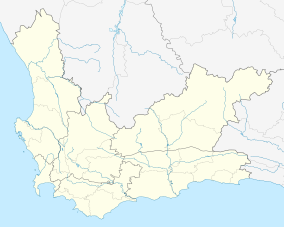
Meganthropus is an extinct genus of non-hominin hominid ape, known from the Pleistocene of Indonesia. It is known from a series of large jaw and skull fragments found at the Sangiran site near Surakarta in Central Java, Indonesia, alongside several isolated teeth. The genus has a long and convoluted taxonomic history. The original fossils were ascribed to a new species, Meganthropus palaeojavanicus, and for a long time was considered invalid, with the genus name being used as an informal name for the fossils.

The Cradle of Humankind is a paleoanthropological site and is located about 50 km (31 mi) northwest of Johannesburg, South Africa, in the Gauteng province. Declared a World Heritage Site by UNESCO in 1999, the site is home to the largest concentration of human ancestral remains anywhere in the world. The site currently occupies 47,000 hectares (180 sq mi) and contains a complex system of limestone caves. The registered name of the site in the list of World Heritage Sites is Fossil Hominid Sites of South Africa.

Zhoukoudian Peking Man Site (周口店北京人遗址), also romanized as Choukoutien, is a cave system in suburban Fangshan District, Beijing. It has yielded many archaeological discoveries, including one of the first specimens of Homo erectus, dubbed Peking Man, and a fine assemblage of bones of the gigantic hyena Pachycrocuta brevirostris.

Gigantopithecus is an extinct genus of ape from roughly 2 million to 350,000 years ago during the Early to Middle Pleistocene of southern China, represented by one species, Gigantopithecus blacki. Potential identifications have also been made in Thailand, Vietnam, and Indonesia. The first remains of Gigantopithecus, two third molar teeth, were identified in a drugstore by anthropologist Ralph von Koenigswald in 1935, who subsequently described the ape. In 1956, the first mandible and more than 1,000 teeth were found in Liucheng, and numerous more remains have since been found in at least 16 sites. Only teeth and four mandibles are known currently, and other skeletal elements were likely consumed by porcupines before they could fossilise. Gigantopithecus was once argued to be a hominin, a member of the human line, but it is now thought to be closely allied with orangutans, classified in the subfamily Ponginae.

Homo rhodesiensis is the species name proposed by Arthur Smith Woodward (1921) to classify Kabwe 1, a Middle Stone Age fossil recovered from Broken Hill mine in Kabwe, Northern Rhodesia. In 2020, the skull was dated to 324,000 to 274,000 years ago. Other similar older specimens also exist.
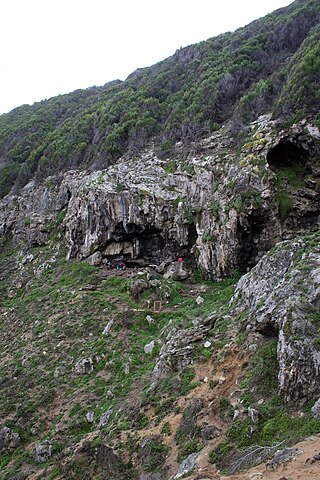
Blombos Cave is an archaeological site located in Blombos Private Nature Reserve, about 300 km east of Cape Town on the Southern Cape coastline, South Africa. The cave contains Middle Stone Age (MSA) deposits currently dated at between c. 100,000 and 70,000 years Before Present (BP), and a Late Stone Age sequence dated at between 2000 and 300 years BP. The cave site was first excavated in 1991 and field work has been conducted there on a regular basis since 1997, and is ongoing.

Fa Hien Cave, also Pahiyangala Cave, is situated in the district of Kalutara, Western Province, Sri Lanka and according to a rural legend, named after an alleged resident during historical times, namely Buddhist monk Faxian. However, there is no archaeological or historical evidence to support this legend. Nonetheless, the site is of archaeological significance as Late Pleistocene human fossilized skeletal remains were discovered in the cave's sediments during excavations in the 1960s, the 1980s and in 2013. This is the largest natural stone cave in South Asia. 3500 people can stay here at the same time. To see the size of the cave, you have to go inside and look outside. Prehistoric humans have lived here for 35000-60000 years.They used sea fish, salt, and shark teeth as ornaments. This limestone was formed by corrosion over hundreds of thousands of years.

Yuanmou Man is a subspecies of H. erectus which inhabited the Yuanmou Basin in Yunnan Province, southwestern China, roughly 1.7 million years ago. It is the first fossil evidence of humans in China, though they probably reached the region by at least 2 million years ago. Yuanmou Man is known only from two upper first incisors presumed to have belonged to a male, and a partial tibia presumed to have belonged to a female. The female may have stood about 123.6–130.4 cm in life. These remains are anatomically quite similar to those contemporary early Homo in Africa, namely H. habilis and H. (e?) ergaster.

AL 129-1 is a fossilized knee joint of the species Australopithecus afarensis. It was discovered in Hadar, Ethiopia by Donald Johanson in November 1973.
Gladysvale Cave is a fossil-bearing breccia filled cave located about 13 kilometres (8.1 mi) northeast of the well-known South African hominid-bearing sites of Sterkfontein and Swartkrans and about 45 kilometres (28 mi) north-northwest of Johannesburg, South Africa. It is situated within the Cradle of Humankind World Heritage Site and is itself a South African National Heritage Site.
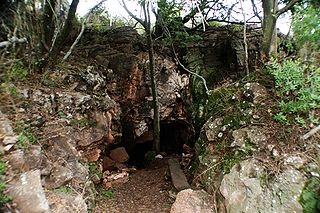
Plovers Lake Cave is a fossil-bearing breccia filled cavity in South Africa. The cave is located about 4 km Southeast of the well known South African hominid-bearing sites of Sterkfontein and Kromdraai and about 36 km Northwest of the City of Johannesburg, South Africa. Plovers Lake has been declared a South African National Heritage Site.
Kromdraai is a fossil-bearing breccia-filled cave located about 2 kilometres (1.2 mi) east of the well-known South African hominid-bearing site of Sterkfontein and about 45 kilometres (28 mi) northwest of Johannesburg, South Africa. It is situated within the Cradle of Humankind World Heritage Site and is itself a South African National Heritage Site.
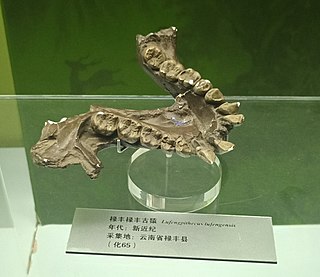
Lufengpithecus is an extinct genus of ape, known from the Late Miocene of East Asia. It is known from thousands of dental remains and a few skulls and probably weighed about 50 kg (110 lb). It contains three species: L. lufengensis, L. hudienensis and L. keiyuanensis. Lufengpithecus lufengensis is from the Late Miocene found in China, named after the Lufeng site and dated around 6.2 Ma. Lufengopithecus is either thought to be the sister group to Ponginae, or the sister to the clade containing Ponginae and Homininae.

Eve's footprint is the popular name for a set of fossilized footprints discovered on the shore of Langebaan Lagoon, South Africa in 1995. They are thought to be those of a female human and have been dated to approximately 117,000 years ago. This makes them the oldest known footprints of an anatomically-modern human. The estimated age of Eve's footprint means that the individual who left the tracks in the soil, thought to be female, would have lived within the current wide range of estimates for the date of Mitochondrial Eve.
The Florisbad archaeological and paleontological site is a provincial heritage site in Brandfort in the Free State province of South Africa. The most notable find at this site is the Florisbad Skull, the partial skull of an early human species that was discovered in 1932.
Pinnacle Point a small promontory immediately south of Mossel Bay, a town on the southern coast of South Africa. Excavations since the year 2000 of a series of caves at Pinnacle Point have revealed occupation by Middle Stone Age people between 170,000 and 40,000 years ago. The focus of excavations has been at Cave 13B (PP13B), where the earliest evidence for the systematic exploitation of marine resources (shellfish) and symbolic behaviour has been documented, and at Pinnacle Point Cave 5–6 (PP5–6), where the oldest evidence for the heat treatment of rock to make stone tools has been documented. The only human remains have been recovered from younger deposits at PP13B which are c. 100,000 years old.

Diepkloof Rock Shelter is a rock shelter in Western Cape, South Africa in which has been found some of the earliest evidence of the human use of symbols, in the form of patterns engraved upon ostrich eggshell water containers. These date around 60,000 years ago.
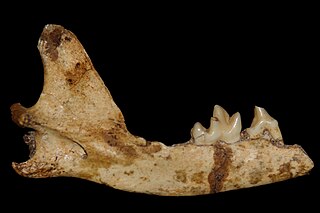
Vulpes skinneri is a species of extinct fox in the genus Vulpes from the early Pleistocene, identified based on fossil remains dated to about 2 million years ago. The species is known from a single partial skeleton discovered in the Malapa Fossil Site at the Cradle of Humankind World Heritage Site in South Africa and is associated with the fossil hominin remains of Australopithecus sediba. The fossils have been dated to between 1.977 and 1.980 million years ago. Hartstone-Rose and colleagues described the remains as a newly discovered species of fox, which they named skinneri after the African mammalogist John Skinner.
Elands Bay Cave is located near the mouth of the Verlorenvlei estuary on the Atlantic coast of South Africa's Western Cape Province. The climate has continuously become drier since the habitation of hunter-gatherers in the Later Pleistocene. The archaeological remains recovered from previous excavations at Elands Bay Cave have been studied to help answer questions regarding the relationship of people and their landscape, the role of climate change that could have determined or influenced subsistence changes, and the impact of pastoralism and agriculture on hunter-gatherer communities.
An ammoglyph is a name given to fossilized art works created by early humans. They are a special kind of aeolianites. This term was coined by Charles William Helm, lead researcher in the excavation of these fossilized pieces and is a relatively new discovery within the 2019 year.

